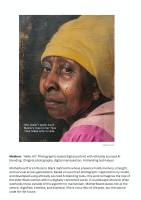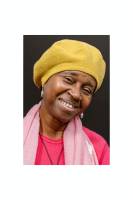Motherboard (Haiku art / mixed media)
Digital or visual media
Masumi, M. 2025. Motherboard (Haiku art / mixed media).
| Creators | Masumi, M. |
|---|---|
| Description | MotherBoard stands as a tribute to Black British Windrush matriarchs whose presence embodies memory, strength, and survival across generations. These Great Grandmothers, Grandmothers and Mothers represent a legacy we are losing daily as mortality forms the natural evolution of life. Based on a portrait photograph captured in my studio and developed using ethically sourced AI blending tools, this work reimagines the role of elder Black British women within a digitally connected world. Ethical AI Process The term "ethically sourced AI blending tools" refers specifically to my methodological approach where all portrait images used were my own original photographs, created with explicit permission from the model. I deliberately blended these contemporary photographs with specific historical artworks from The Metropolitan Museum of Art's Open Access collection: Jacques de Gheyn II's "Vanitas Still Life" (1603) These works were accessed through The Met's Open Access policy, which allows free copying, modification, and distribution of these images, even for commercial purposes. By consciously selecting European artists' historical artworks as base elements, I engage in a deliberate artistic intervention that confronts colonialism in a contemporary context, using the very visual languages and traditions that historically excluded Black subjects to now center and elevate them. In a landscape where AI often overlooks those outside the algorithmic mainstream, MotherBoard places her at the centre, dignified, timeless, and essential. Motherboard is not a relic of the past but the source code for the future. This piece forms my submission for the 'AI for Good': Canvas of the Future 2025 call-out and constitutes part of my wider practice in tech art archival, employing photography, AI, and digital art (Mixed Media) to preserve, honour and future-proof the cultural presence of Black women in global memory systems. The work comprises two versions (Haiku in English and Haiku in Jamaican Patois) alongside an accompanying Short Shorts video. The English version was submitted to 'AI for Good'. Prompt Title: Motherboard: Wisdom Woven in Skin The work utilises Renaissance-inspired oil painting textures with metallic undertones in her clothing—blending golds, rose pinks, and earth browns. Her headwrap symbolises cultural continuity, while faint abstract patterns surrounding her reference oral storytelling, migration, and memory. The portrait embodies warmth, dignity, and introspection, framing the woman as a living archive: her gaze quiet, yet speaking to centuries of resilience and creativity. This work explicitly resists AI's tendency to erase or stylise Black skin inaccurately by prioritising fine-grained detail, deep tones, and culturally specific features. Retain the photo realism and dark skin tone (vital as AI does enter the realms of colourism heavily) Technical Parameters Style: Romanticism, Ethnographic realism, Renaissance, Afro-surrealism Conceptual Framework My work sits firmly within cultural, linguistic, and feminist anthropology, examining how visual representation intersects with identity formation and preservation. My choice of the old master style from the Renaissance period is deliberate, drawing on their established visual narratives of social conduct and moral standards (Hall, 2019). By appropriating historical European artistic styles and specific works from The Met's collection, I enact what Tuck and Yang (2012) call "counter-appropriation," reclaiming colonial aesthetics for decolonial purposes. Without the next generations preserving their existence, Black British women risk being lost from our collective memory. As technology becomes the new tool for presence, it becomes our responsibility to ensure these women are part of tech conversations both off and online. My blending prompts draw inspiration from my love of the Memento Mori and Vanitas artistic traditions, while my mixed-media Visual Ethnography and Cultural Mortality documents cultural identities historically marginalised, erased, or devalued. In this sense, my portraits function as anti-vanitas, refusing the symbolic death of Black British Windrush women by centring them within cultural legacy. As Bryan et al. (2018) observe, Black British women's histories have been systematically excluded from mainstream archives, creating what they term "archival silences." This work attempts to address these silences through digital reclamation. The inclusion of Jamaican Patois in one version of the haiku engages with linguistic anthropology by elevating creolised languages within academic and artistic contexts (Sebba, 2021). Jamaican Patois is considered a creole language by linguists. It's a language that has evolved from a pidgin, or a mixture of languages, often influenced by West African languages, English, and other languages. While vanitas reminds us of mortality, my work reclaims the dignity of lives often excluded from official memory, particularly elder Black British women. This aligns with my Anthro-Digital Narratives (ADN) framework, which positions lived experience, heritage, and memory as legitimate sites of knowledge production (Barrett, 2020). These portraits disrupt the silent death imposed by historical erasure, presenting instead a visual form of intellectual, emotional, and ancestral survival. As Noble (2018) argues, algorithmic systems frequently perpetuate historical biases, making intentional counter-narratives essential for digital equity. From a feminist anthropological perspective, this work challenges the technological determinism that often excludes elder women from digital spaces (Strathern, 2016). Symbolism and AI Ethics AI systems often flatten identity into generic categories. My images echo the vanitas tradition of layered symbolism; skin texture, headwraps, and expression function as cultural artefacts. This approach combats algorithmic bias by forcing AI into ethical confrontation with complexity and human texture. MotherBoard's portrait holds the same solemnity and stillness as a vanitas work; she appears timeless, contemplative, neither fully in the past nor future. This represents AI as a space for reclaiming rather than erasing. Research by Benjamin (2019) demonstrates how technologies often reproduce racial hierarchies, requiring deliberate interventions like this portrait to disrupt such patterns. Cultural anthropologists like Ginsburg (2018) have noted the importance of 'cultural futures' work that ensures indigenous and minority communities remain visible in emerging technological landscapes. The Skull (mortality): Wrinkled skin and soft gaze (lived experience, memory) The MotherBoard portrait becomes a living vanitas, but instead of mourning lost time, it preserves it, making visible the "ordinary" Black British Windrush woman as extraordinary, layered, symbolic, and central to cultural memory. This work exemplifies the use of traditional and contemporary art styles to create empowerment and visibility through visual narration on digital platforms. It represents my contribution as a PhD student to recognising what these women did before me and did to enable my presence in academia today. As discussed by Wekker (2016), honouring Black women's knowledge production becomes an act of both preservation and resistance. Feminist anthropological approaches frame this work as what Behar (2013) terms 'vulnerable ethnography'—research that acknowledges emotional connection to cultural documentation. |
| Keywords | AI for Good; Representation and resistance; Inclusive innovation; Digital archive; Black British women; AI art; Mixed media art; Poetry; Jamaica; Patois; Techart Archival; Cultural memory; Digital identity; Visual ethnography; Cultural anthropology |
| Date | 18 Apr 2025 |
| Related URL | https://aiforgood.itu.int/canvas-of-the-future-2025/ |
| https://www.linkedin.com/feed/update/urn:li:activity:7319828455552942081/ | |
| Files | Image credit Michi Masumi Measurements A2 Rights Michi Masumi Media type Image License File Access Level Open |
| Files | Image credit Michi Masumi Measurements A2 Rights Michi Masumi Media type Image License File Access Level Open |
| Files | Image credit Motherboard the Video Measurements For streaming Rights Michi Masumi Media type Video License File Access Level Open |
| Files | Image credit Michi Masumi and Sista Eureka (Model) Measurements A4 Rights Michi Masumi Media type Image License File Access Level Open |
| Files | Image credit https://www.metmuseum.org/ Measurements Varied Rights The Met Museum Media type Image License File Access Level Open |
| References | Barrett, J. (2020) 'Digital ethnography and cultural memory: methodological approaches to online archives', Journal of Cultural Memory Studies, 15(3), pp. 217-233. |
Behar, R. (2013). The vulnerable observer: anthropology that breaks your heart. Boston: Beacon Press. | |
Benjamin, R. (2019). Race after technology: abolitionist tools for the new Jim Code. Cambridge: Polity Press. | |
Bhabha, H.K. (2022) Digital diasporas: location and identity in virtual spaces. London: Routledge. | |
Blakelock, R.A. (1885-95). Landscape [Oil on canvas]. The Metropolitan Museum of Art, New York. Available at: https://www.metmuseum.org/art/collection/search/10181 (Accessed: 20 June 2022). | |
Bryan, B., Dadzie, S. and Scafe, S. (2018). The heart of the race: Black women's lives in Britain. 2nd edn. London: Verso. | |
de Gheyn II, J. (1603) Vanitas Still Life [Oil on wood]. The Metropolitan Museum of Art, New York. Available at: https://www.metmuseum.org/art/collection/search/436485 (Accessed: 20 June 2022). | |
Fantin-Latour, H. (1883) Roses in a Bowl [Oil on canvas]. The Metropolitan Museum of Art, New York. Available at: https://www.metmuseum.org/art/collection/search/437995 (Accessed: 20 June 2022). | |
Ginsburg, F. (2018) 'Decolonizing documentary on-screen and off: sensory ethnography and the aesthetics of accountability', Film Quarterly, 72(1), pp. 39-49. | |
Hall, S. (2019). Essential essays: identity and diaspora. Durham: Duke University Press. | |
hooks, b. (1992) Black looks: race and representation. Boston: South End Press. | |
Masumi, M., 2025. Anthro-Digital Narratives (ADN™) Framework: A Methodology for Black British Visual and Poetic Research. Unpublished doctoral research output. Canterbury Christ Church University. | |
Masumi, M., 2025. Masumi Applied Ethnographic Tools and Theories (MAETT™): Ethnographic Research for Neurodivergent and Marginalised Communities. Unpublished doctoral research output. Canterbury Christ Church University. | |
Masumi, M., 2025. Masumi Methodology of Art and Technology (MMAT™): A Practice-Based Approach to Intersectional Digital Humanities. Unpublished doctoral research output. Canterbury Christ Church University. | |
Mercer, K. (2023) 'Digital textures: Black British art in the age of algorithms,' British Art Studies, 8(2), pp. 45-63. | |
Noble, S.U. (2018) Algorithms of oppression: how search engines reinforce racism. New York: NYU Press. | |
Perez, C.C. (2019) Invisible women: exposing data bias in a world designed for men. London: Chatto & Windus. | |
Sebba, M. (2021). Creole linguistics and British language policy: the case for recognition. London: Routledge. | |
Simpson, L.B. (2017). As we have always done: indigenous freedom through radical resistance. Minneapolis: University of Minnesota Press. | |
Strathern, M. (2016) Before and after gender: sexual mythologies of everyday life. Chicago: HAU Books. | |
The Metropolitan Museum of Art (2023) Open Access Policy. Available at: https://www.metmuseum.org/about-the-met/policies-and-documents/open-... (Accessed: 03 March 2021 and 20 APril 2025 ). | |
Tuck, E., and Yang, K.W. (2012) 'Decolonization is not a metaphor,' Decolonization: Indigeneity, Education & Society, 1(1), pp. 1-40. | |
Wekker, G. (2016). White innocence: paradoxes of colonialism and race. Durham: Duke University Press. | |
| Additional information | MotherBoard sits at the intersection of Black British female representation, technological innovation and visual memory work. It contributes to a growing field of academia that critiques the underrepresentation and misrepresentation of Black women in both traditional and digital cultural archives (Tate, 2015; Evaristo, 2019). My work engages deeply with Stuart Hall's notion of cultural identity as "becoming" as well as "being," embodying the lived experiences of Black women as both rooted in history and actively shaping future narratives (Hall, 1990). This duality, of honouring ancestral wisdom whilst projecting forward into digital futures, creates a temporal bridge across generations of Black British womanhood. By using my original studio portraiture layered with ethically sourced AI techniques, MotherBoard contributes to existing knowledge discussions about algorithmic bias and digital erasure. Where scholars like Noble (2018) and Benjamin (2019) have called for anti-racist, culturally conscious technologies, my artwork manifests these theories in visual form. My portrait functions as a tech art archive, a form of visual resistance to disappearing identities in datasets and digital infrastructures. It visualises what Ruha Benjamin terms "coded inequity", simultaneously proposing aesthetic repair through intentional, inclusive image-making (Benjamin, 2019). This reparative approach challenges AI's tendency to flatten cultural specificity and erase the textured realities of Black lives. MotherBoard meaningfully expands the underexplored visual archive of elder Black British women, celebrating them not only as carriers of legacy but as central figures in imagining more inclusive, ethical futures in both art and artificial intelligence. My portrait refuses the passive role often assigned to elders, instead positioning them as knowledge bearers essential to technological progress. Within my doctoral research under the ADN Framework© and MMAT™, this artwork exemplifies practice-based methodologies that use lived experience, fine art and AI to interrogate and reframe who gets to be remembered, seen and stored in the digital age. The inclusion of two original studio portraits from the series of Sista Eureka enables viewers to witness my ethical process, revealing how I use AI Blending as a tool alongside traditional editing software like Lightroom and Photoshop. My transparency provides clear evidence that the type of AI mixed media art I create is ethical and sustainable, I continue to recycle my Portraits, still life, street and Floral photographs to create new cultural visual outputs. By making visible both the source materials and the final creation, the work demystifies AI art production whilst maintaining the dignity and agency of the portrait subject. |
| Publication process dates | |
| Deposited | 23 Apr 2025 |
https://repository.canterbury.ac.uk/item/9qx8q/motherboard-haiku-art-mixed-media
Download files
Files
| Motherboard - Haiku Art - Michi Masumi - April 2025.jpg | ||
| License: CC BY-NC-ND 4.0 | ||
| File access level: Open | ||
| MotherBoard - Michi Masumi April 2025 - PDF V2 Patois.jpg | ||
| License: CC BY-NC-ND 4.0 | ||
| File access level: Open | ||
 | Motherboard - Visual Ethnography - Michi Masumi 20 April 2025 (1).mp4 | |
| License: CC BY-NC-ND 4.0 | ||
| File access level: Open | ||
| Sista Eureka - PHD Portrait series - Michi Masumi Feb 2025 (1).jpg | ||
| Sista Eureka - PHD Portrait series - Michi Masumi Feb 2025 (2).jpg | ||
| License: CC BY-NC-ND 4.0 | ||
| File access level: Open | ||
5
total views8
total downloads5
views this month8
downloads this month
Export as
Related outputs

I soon will be history
Masumi, M. 2025. I soon will be history.
Art, activism, aesthetics & AI (SCANDI presentation) Includes short videos
Masumi, M. 2025. Art, activism, aesthetics & AI (SCANDI presentation) Includes short videos.Anthro-Digital Narratives (ADN) framework & EthnoGo mobile app prototype V1
Masumi, M. 2025. Anthro-Digital Narratives (ADN) framework & EthnoGo mobile app prototype V1.
Riddum n ting
Masumi, M. 2024. Riddum n ting. Freddie's Livelounge, 3 Duke Street, Margate, Kent , UK 18 - 18 Dec 2024Vernacular portrait - Afro child
Masumi, M. Vernacular portrait - Afro child.Vernacular portraits: Exploring the Windrush Generation's encounter with snow
Masumi, M. Vernacular portraits: Exploring the Windrush Generation's encounter with snow.
Intersectionality art exhbition video (Black History Month 2024 UK)
Masumi, M. 2024. Intersectionality art exhbition video (Black History Month 2024 UK). Medway, Kent. England UKThe Chatterday Show (Spotify) E23
Masumi, M. 2024. The Chatterday Show (Spotify) E23.Intersectionality
Masumi, M. 2024. Intersectionality . Intra Arts, Rochester, Kent 16 Sep - 24 Oct 2024Echoes of empire
Masumi, M. 2024. Echoes of empire .Confluence Anthology - Issue 16
Masumi, M. 2024. Confluence Anthology - Issue 16. KentQueerdom: Solo exhibition for Medway Fringe/ Medway Pride
Masumi, M. 2024. Queerdom: Solo exhibition for Medway Fringe/ Medway Pride. Poco Loco, High Street, Chatham, Kent ME4 12 Aug - 17 Dec 2024Movement
Masumi, M. 2024. Movement.Medway Open Studios and Arts Festival 2024
Masumi, M. 2024. Medway Open Studios and Arts Festival 2024.MICHI exhibition
Masumi, M. 2024. MICHI exhibition. No 64 Coffee and Brunch, Chatham, Kent ME4 20 Jun - 05 Jul 2024
Open mic poetry performance
Masumi, M. 2024. Open mic poetry performance .In da corner (The young lovers)
Masumi, M. In da corner (The young lovers).Click and connect: Interview with Medway photographyer Michi Masumi
Masumi, M. 2024. Click and connect: Interview with Medway photographyer Michi Masumi. Kent
BLACK JOY! Up Close and Personal
Masumi, M. 2024. BLACK JOY! Up Close and Personal . HastingsVisibility - Black transgender photo series
Masumi, M. 2024. Visibility - Black transgender photo series. Playing the Race Card.Vernacular [Family portraits]
Masumi, M. 2024. Vernacular [Family portraits].






